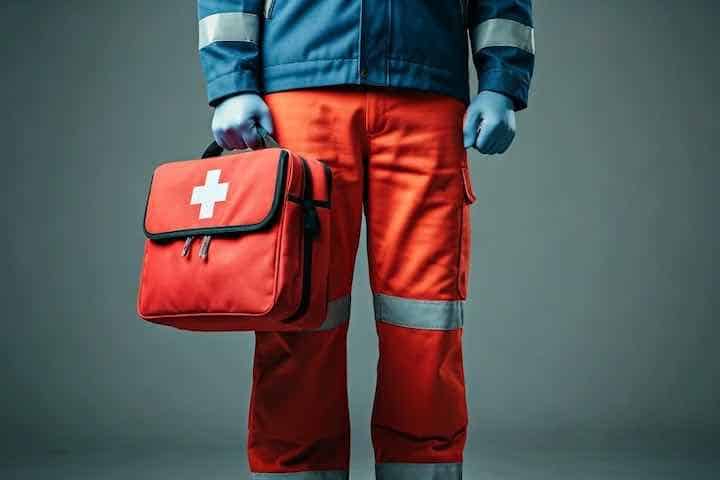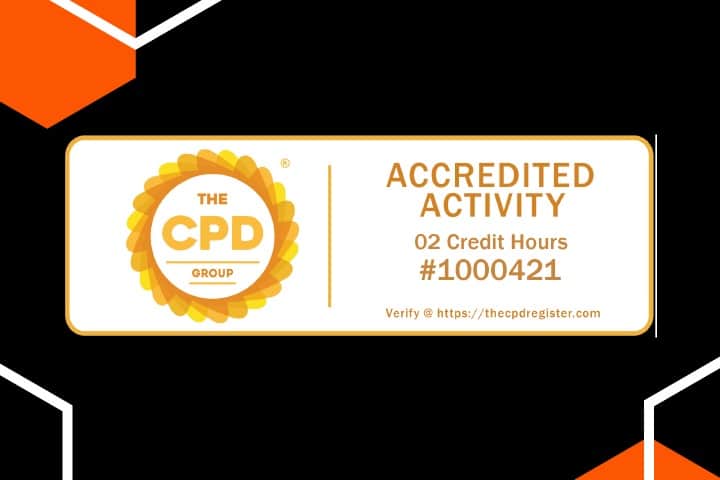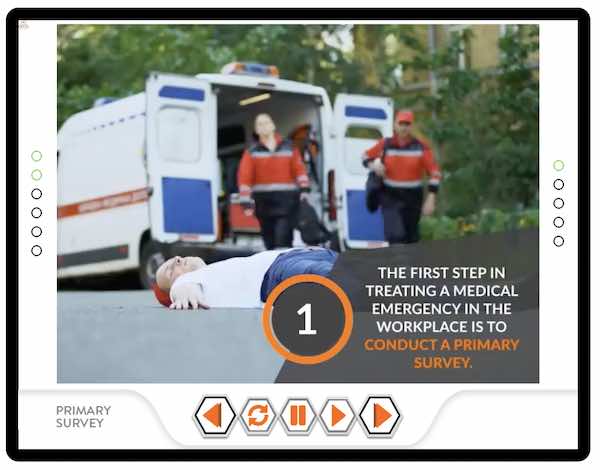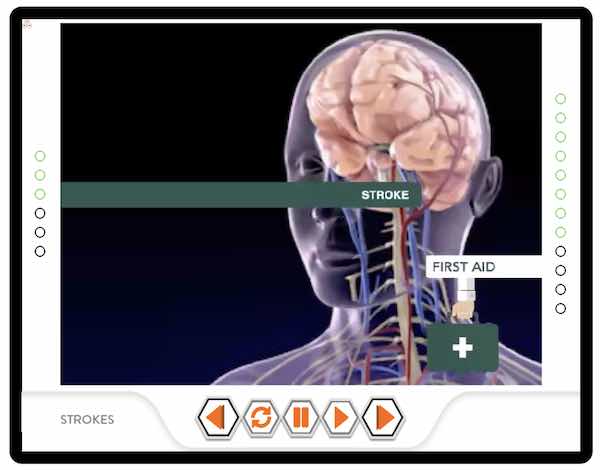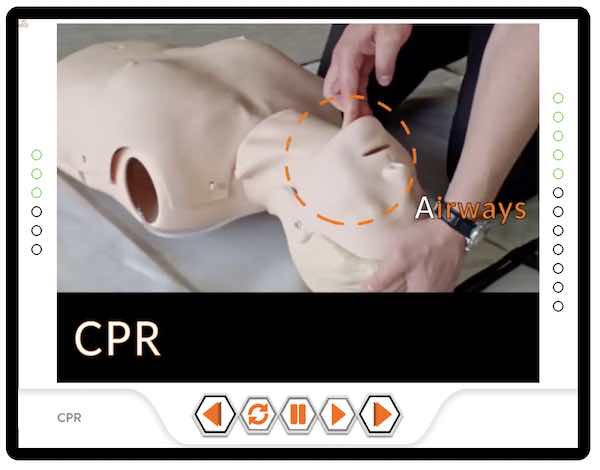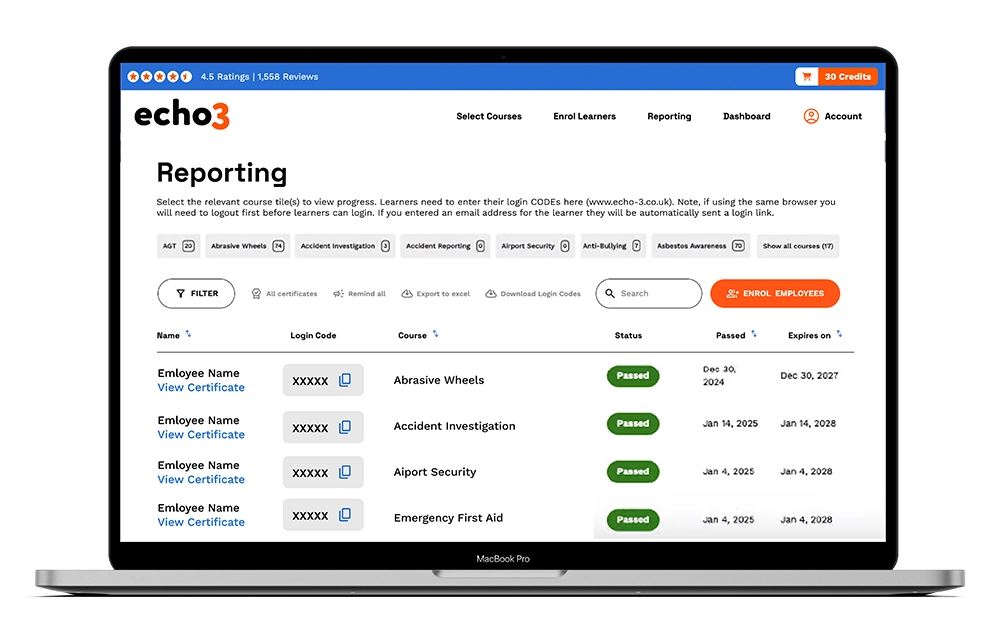Online Fire Aid at Work course
The Echo3 First Aid at Work online course equips learners with the essential knowledge to respond effectively to a wide range of medical emergencies in the workplace. Fully accredited and aligned with the UK HSE First Aid at Work syllabus, this comprehensive course covers both life-threatening and non-life-threatening situations.
First aid refers to the immediate care given to someone who is injured or becomes ill, before professional medical help is available. In emergencies, basic first aid can significantly improve outcomes and even save lives.
For this reason, employers have a legal duty to ensure adequate first aid provisions are in place, so that any employee who falls ill or is injured at work can receive prompt and appropriate attention.
What counts as “adequate” provision is determined through a First Aid Needs Assessment, which will consider the specific risks and requirements of your workplace. Adequate provision must include ‘appropriate’ staff training.
The Echo3 First Aid at Work course is delivered entirely online and is designed to provide an appropriate first aid training solution for employers in small, low-risk businesses. It may also be appropriate for remote workers, useful as an annual refresher, or as basic awareness training for all staff in higher-risk workplaces.

FAW Course Content
Unit 1 – Introduction:
This opening unit provides an overview of emergency first aid in the workplace and the key regulations that govern it. While we all hope never to face a situation requiring first aid, being prepared is essential to respond effectively and confidently if an emergency does occur.
Unit 2 – Surveys:
In this unit, we focus on the first steps to take in a medical emergency. This includes the critical importance of ensuring the environment is safe before offering help, followed by how to carry out both primary and secondary surveys to assess the casualty’s condition.
Unit 3 – Life-Threatening Emergencies:
If the primary survey reveals a life-threatening condition, it’s crucial to act quickly and correctly. This unit outlines the essential steps to take in such situations, including how to respond to cardiac arrest, heart attack, stroke, external bleeding, and shock.
Unit 4 – Non-Life-Threatening Emergencies:
Following the secondary survey, this unit explains the appropriate steps to take when managing a range of common workplace injuries and illnesses. Topics include fractures, sprains, unconsciousness, burns, poisoning, electrical injuries, seizures, allergic reactions, and diabetic emergencies.
Unit 5 – Workplace Best Practice:
While some procedures may seem straightforward, reinforcing the basics is key to building confidence. In this unit, we review best practices for contacting emergency services, provide a brief overview of RIDDOR (Reporting of Injuries, Diseases and Dangerous Occurrences Regulations), and offer guidance on supporting an employee’s return to workafter illness or injury.
Unit 6 – Quiz:
To complete the course, you’ll take a 15-question multiple-choice quiz to test your understanding of the key topics covered.
First Aid at Work Certificate
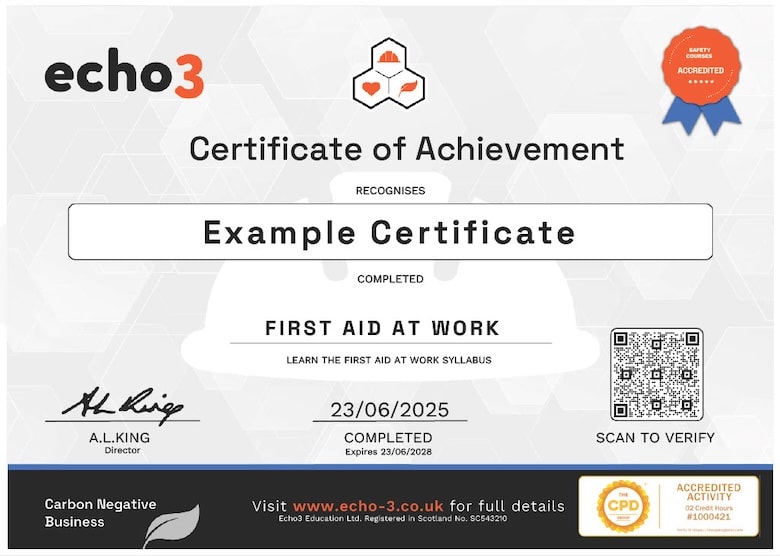
Download and Print Your Certificate
- Written in compliance with the Health and Safety (First-Aid) Regulations 1981
- Developed by qualified health and safety professionals
- Accredited by CPD – learn more about CPD here
- Last Updated June 2025
- To gain the certificate you must complete the assessment which involves 15 questions.
- The online First Aid at Work certificate is valid for 3 years.
Course Preview
Echo3 courses include engaging motion-graphic video content, with full english subtitles
Reviews
How to Get Certified in 3 Steps
Individual Learners

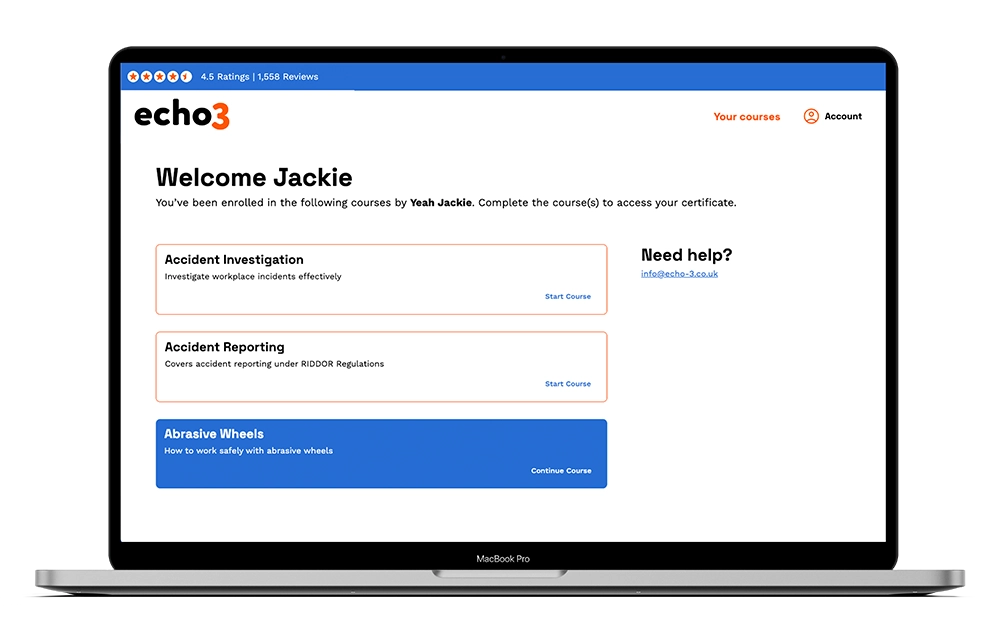
Benefits for Individuals
-
Engaging video-based content
-
Learner dashboard included
-
Instant access after payment
-
Free course retakes
-
Shareable digital certificate
 QR Code Certificate
QR Code Certificate




Bulk Buying Discounts
What are the learning outcomes?
 The online First Aid at Work course learning objectives include:
The online First Aid at Work course learning objectives include:
First Aid Surveys, how to evaluate the situation when first encountering a victim.
Life-saving Techniques, cardiopulmonary resuscitation (CPR) for adults, and how to use automated external defibrillators (AEDs).
Medical Emergencies, manage common workplace medical emergencies, such as heart attacks, strokes, and diabetic emergencies.
Injury Assessment, how to assess and provide first aid for common workplace injuries such as cuts, burns, fractures, and sprains.
Choking Response, how to recognise and respond to choking incidents.
Bleeding Control, control severe bleeding and preventing shock.
Poisoning and Chemical Exposure, awareness of potential workplace hazards, such as chemical exposure and poisoning, and how to respond.
Legal Considerations, ensuring that first-aid supplies are readily available.
Is online First Aid at Work training appropriate?
 You should check with your employer if you are in doubt as to whether this course is appropriate for your job role.
You should check with your employer if you are in doubt as to whether this course is appropriate for your job role.
Employers have a duty to provide employees with appropriate training. This starts with undertaking a First Aid Needs Assessment to determine the correct training for any give job role.
If you are a contractor working for a bigger organisation, you need to check first with ‘duty holder’ whether an online First Aid at Work course is appropriate for their working environment.
Situations where an online First Aid at Work course may be appropriate can include.
- Small low-risk businesses employing under 25 staff
- For remote workers or small remote teams
- For every employee in higher-risk business
- As part of a ‘blended’ training programme which includes face-to-face practice
- As an annual refresher for First Aiders
- For the person appointed to manage first aid arrangements
The Health & Safety Executive recommends that a qualified, First Aid at Work first-aider should undergo an 18-hour face-to-face course.
Who should take this First Aid at Work course?
 This first aid at work online course is designed for;
This first aid at work online course is designed for;
- The ‘appointed person’ in low-hazard workplaces employing fewer than 25 staff.
- The ‘appointed person’ in higher hazard workplaces employing fewer than 5 staff.
- The online element of a ‘blended’ first-aider qualification.
- As an annual refresher course for 18-hour FAW qualified first-aiders. (Annual refresher training is not mandatory but is ‘strongly recommended’ but the HSE.)
- Remote workers and employees working in small satellite teams.
- All staff in ‘higher hazard’ business for example engineering, construction, warehousing and food or drink processing.
What are first aid legal requirements?
What are first aid legal requirements?
The law defining employer duties is the First-Aid Regulations 1981.
First-Aid regulations require “employers to provide adequate and appropriate equipment, facilities and personnel to ensure their employees receive immediate attention if they are injured or taken ill at work.”
To achieve this, it is recommended that every business.
- Completes a first aid needs assessment.
- Has an appropriately stocked first aid kit.
- Appoints someone to maintain first aid arrangements.
- Communicate arrangements to staff
- Provide appropriate first aid training to staff.
- Report workplace injuries the lead to an employee missing over 7 days from work (RIDDOR).
Is it a heart attack or cardiac arrest?
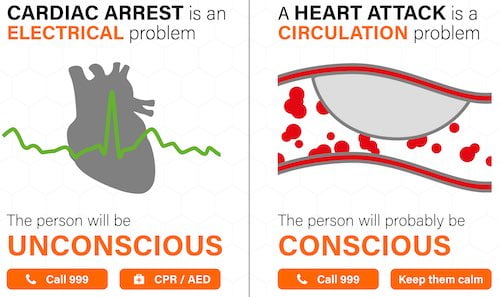
Heart Attacks
Heart attacks are caused by the blood supply to the heart being suddenly interrupted. Usually this stems again from a build-up of cholesterol plaque within a coronary artery. The plaque in this instance cracks which leads to the formation of a blood clot which blocks the artery and the supply of blood to the heart.
Heart attacks are a common cause of sudden cardiac arrest, but most heart attacks do not lead to sudden cardiac arrest.
Cardiac Arrest
Cardiac arrest means the heart is no longer moving blood through the body.
When blood circulation stops, the brain shuts down, including its respiratory centre. So, when the heart stops, so does breathing, usually within a minute or less.
Causes of cardiac arrest include:
- Electrocution
- A drug overdose
- Losing a large amount of blood
- Suffocation
But most cardiac arrests occur when a diseased heart’s electrical system malfunctions. This is know as sudden cardiac arrest or SCA. There is often little or no warning.
A victim will lose consciousness, have absent or abnormal breathing and no circulation.
Sudden cardiac arrest is the leading cause of death. Each year around 350,000 incidents occur in the US and 100,000 in the UK.
This online First Aid course provides colleagues with the knowledge needed to recognise and respond appropriate to sudden cardiac arrest and heart attacks.
What is a stroke?
Strokes happen when the blood supply to part of the brain is cut off by a blood clot. Strokes are a medical emergency and urgent treatment is essential.
If you suspect someone is having a stroke, think ‘FAST’:
Face – ask them to smile. If they are only able to smile on one side of their mouth and/or their eye may also have dropped – this is not normal.
Arms – ask them to raise both arms. If they are only able to lift one arm – this is not normal.
Speech – ask them to speak. If their speech is slurred or garbled, or they are unable to talk despite being awake – this is not normal.
Time – if you see any of these signs or symptoms you must dial 999 immediately and tell them you think the casualty is having a stroke.
Strokes are a serious life-threatening condition, there are more than 100,000 strokes in the UK each year. That’s around one stroke every five minutes.
What is the importance of first aid training?
Recent research shows only 5%, or 1 in 20, adults have the confidence to provide first aid in emergency situations. This First Aid at Work online course gives staff the knowledge and confidence to stay calm and provide the right care or treatment in an emergency.
Even a basic knowledge of first aid can enable a lifesaving intervention.





